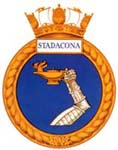 STADACONA, Halifax - July 1, 1923 to April 1, 1966. Originally
located at HMC Dockyard, it moved into the Army's Wellington (later Nelson)
Barracks alongside Admiralty House in early 1941. It eventually became
the part of CFB Halifax bounded by Barrington, North Gottingen and Russell
Streets. Stadacona took over basic radio training from St. Hyacinthe
in the 1945-46 time frame. Approval for the establishment of the
Electrical School was given in September, 1945. By June, 1946, the renovation
and fitting out of the building assigned to the school had begun. It was
not until January, 1947, that training courses began in the Electrical
School with the first course for Electrician's Mates.
STADACONA, Halifax - July 1, 1923 to April 1, 1966. Originally
located at HMC Dockyard, it moved into the Army's Wellington (later Nelson)
Barracks alongside Admiralty House in early 1941. It eventually became
the part of CFB Halifax bounded by Barrington, North Gottingen and Russell
Streets. Stadacona took over basic radio training from St. Hyacinthe
in the 1945-46 time frame. Approval for the establishment of the
Electrical School was given in September, 1945. By June, 1946, the renovation
and fitting out of the building assigned to the school had begun. It was
not until January, 1947, that training courses began in the Electrical
School with the first course for Electrician's Mates.
As reported in Crowsnest Magazine, the move of the Comm School, scheduled for late September, 1951 was titled "Operation Homestead". Completed within a week on October 1, classes resumed with the loss of only two full training days. Among the equipment that was moved was 300 typewriters. Amateur stations VE1HO and VE1RN also operated in Stadacona. Select this link to read the story about those stations. On Jan 21, 1953 amateur station VE1NN was established to fill the the void left by VE1HO and VE1RN. VE1NN was registered to the Officer-in-Charge, Academic Division , HMCS Stadacona, Halifax.
This article, from April 1949 Crowsnest Magazine, details the courses offered in the electrical school.
Jim Dean recalls his training at Stadacona. "I was first at Stadacona in June 1957 for my third summer training as an ROTP officer cadet. Before going to sea in ASSINIBOINE, I spent a month in the Fleet School, Halifax, (which after unification became the Canadian Forces Fleet School, Halifax (CFFSH)). In 1957, the Fleet School was certainly well established with several divisions. The Weapons Div was on one side (north) of the parade square and the Ops Div was on the other side (south). On the east side was an accommodation block known as Wellington Barracks, some of which were married quarters and some of which were accommodation for wardroom overflow. On the west side of the parade square was "A" block, which was the quarters for LS and below who were on course or awaiting a draft to a ship.
Below the Wellington Barracks, the Engineering Division was (and still is) located in some "temporary" wooden buildings. The Electrical Division was located on the east side of the playing field which was south of Wellington barracks and the Ops Div. The Weapons Div, Ops Div and Electrical Div were strong brick buildings that could take a direct hit from a six-inch shell!
In 1957, the Fleet School was going strong and as far as I know that was where all initial trades training was done. Comm training, at least the theory and technical aspects, was done in one end of the Electrical Division building. I know, because I did some there. I am not sure where the Sparkers learned their Morse, but I think it was in the Electrical Div building as well. Training of radiomen was always one of the most intensive, lengthy and expensive initial trades training. Radiomen had to learn to touch type and to copy Morse at the NATO standard of 22 wpm. One cannot do that continuously all day, so the Morse and typing sessions were broken up with other aspects of radio training such as equipment operation. Visual signalmen were trained there too, because we cadets joined them on the playing field for morning Morse (by lamp), semaphore and flag training.
The Fleet School is still using those buildings and more have been added. The Boatswains Div was variously located in old wooden buildings at Windsor Park and in the Dockyard where they could do actual boat work. The NBCD School is located near Chebucto Head behind the old York Redoubt harbour defence gun emplacements.
With the arrival of the DDH 280 class, in 1970/71 a new Division was added to the Fleet School to do the operational and technical training for these new ships. That was the Combined Support Division (CSD) of the CFFSH, and it was located on the Dartmouth side of the harbour on the grounds of the Naval Armament Depot (NAD). I was the Combat System Engineering (CSE) Officer designate of HMCS IROQUOIS, the lead ship of class. I, and two others, did our CSE training for the ships at the CSD from July 1971 to March 1972 and then we went to stand by our ships in the final construction and trials phases. IROQUOIS commissioned 29 July 1972. At that time, our radiomen were all being trained in Fleet School in the Comm Div (Electrical Div building), in which the 280 radio equipment had been installed.
On a personal note, I was privileged to be the OIC of the CSD from July 1978 to July 1982. For some strange reason, people said that CSD meant Curling School Dartmouth! We worked hard and we played hard. It was a great posting.
The CSD is no more. It has been replaced by the Pullen Building, which was provided by the CPF Project for equipment and operational training for the CPFs. There is a long history of the evolution of operational training, software maintenance and testing, and live operational exercises with ships that was started with the CSD and has since been carried on by the CPF setup in the Pullen Building. I spent many evenings at CSD watching our ships exercising off Bermuda, thanks to Link 11. I had no radar contacts but I could tell exactly what the ships and helos were doing due to the Link11 symbology. But this is off the subject of radiomen and comms training".
Badge Description: The design for the badge of H.M.C.S. Stadacona was suggested by the Commanding Officer of the base. A mailed forearm and fist are shown carrying the' 'lampeancienne," symbol of learning and knowledge. The implication is that power is obtained through knowledge or study, which suits the case of the Halifax training establishment.
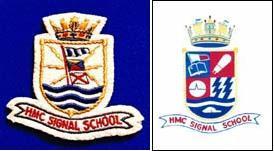 ST. HYACINTHE, Quebec - 1 October 1941 to 20 February 1946.
Commissioned under the command of Captain A. P. Musgrave, this was the
Royal Canadian Navy's Communications School during the Second World War
and was situated 35 miles east of Montreal. Three weeks after commissioning,
Lieut. R. W. Murdoch joined as Chief Instructor Officer. At its peak, the
student population reached about 2,600 and during its almost five years
of service, St. Hyacinthe trained 9,600 sailors, WRENS and Signal Officers
in the many skills of naval communications. It closed its doors shortly
after the end of WWII. Additional details about St. Hyacinthe can
be found in the Wireless Training section of this
document. A tribute to St. Hyacinthe, written in 1986, can
be found here.
ST. HYACINTHE, Quebec - 1 October 1941 to 20 February 1946.
Commissioned under the command of Captain A. P. Musgrave, this was the
Royal Canadian Navy's Communications School during the Second World War
and was situated 35 miles east of Montreal. Three weeks after commissioning,
Lieut. R. W. Murdoch joined as Chief Instructor Officer. At its peak, the
student population reached about 2,600 and during its almost five years
of service, St. Hyacinthe trained 9,600 sailors, WRENS and Signal Officers
in the many skills of naval communications. It closed its doors shortly
after the end of WWII. Additional details about St. Hyacinthe can
be found in the Wireless Training section of this
document. A tribute to St. Hyacinthe, written in 1986, can
be found here.
Badge Descriptions: St. Hyacinthe had two badges. The design on the left was borrowed directly from the Royal Navy and its date of introduction is not known at this time. The one on the right was the winner in a badge design contest held at ST. HYACINTHE in the fall of 1944. Its purpose was to replace the first design. © David Freeman.
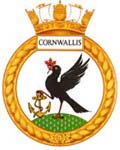 CORNWALLIS , Nova Scotia - 1943 to 1994 (1949 onwards for new
entry training). HMCS Cornwallis was commissioned in Halifax on May 1,
1942. By early 1943 the first buildings in Digby, N.S. were ready and
Cornwallis, with a complement of 2,539, was officially transferred there
in April 1943. HMCS Cornwallis was set up as a basic training establishment
Royal Canadian Naval Volunteer Reserves (RCNVR). It was the largest naval
training base in the British Commonwealth. With the end of the war, Cornwallis
was made a Discharge Transit Centre to process thousands of naval personnel
returning to civilian life. The base was finally declared surplus and,
on February 28, 1946, was paid off by the navy and turned over to War Assets
Corporation for disposal.
CORNWALLIS , Nova Scotia - 1943 to 1994 (1949 onwards for new
entry training). HMCS Cornwallis was commissioned in Halifax on May 1,
1942. By early 1943 the first buildings in Digby, N.S. were ready and
Cornwallis, with a complement of 2,539, was officially transferred there
in April 1943. HMCS Cornwallis was set up as a basic training establishment
Royal Canadian Naval Volunteer Reserves (RCNVR). It was the largest naval
training base in the British Commonwealth. With the end of the war, Cornwallis
was made a Discharge Transit Centre to process thousands of naval personnel
returning to civilian life. The base was finally declared surplus and,
on February 28, 1946, was paid off by the navy and turned over to War Assets
Corporation for disposal.
With the post-war appearance of the Communist threat it was realized the navy again might have use for Cornwallis. In June, 1948, a “stop sale” order was issued, and in September the navy reclaimed possession. Renovations got under way in December, 1948, and on May 1, 1949, Cornwallis was recommissioned. The first Officer-In Charge of the school was and the first commanding officer of the base was Captain Musgrave. The 150 New Entry recruits were split into HAIDA and HURON divisions with 75 personnel in each division [1].
Upon completion of New Entry Training, those designated for training as Communicators would join the Naval Communications School, also located at Cornwallis. Then it was on to Gloucester for further training in the CS and RS trades. When Stadacona handed over basic radio radio training to Cornwallis, amateur radio station VE1HO was part of the package.
In the summer of 1966 [2], the Communication School at Cornwallis was moved to the Fleet Schools in Halifax and Esquimalt. The site chosen at HMCS Naden in Esquimalt was Comm School Bldg 55, the old radar section, now the Bosn Section. Comm training then moved to the Weapons School, Bldg 50, when the Weapons Section moved to the new Fleet School. This was around the time when Cornwallis was designated to become the basic New Entry training school for not just the Navy but for the Army and Air Force as well. Air Force trainees started arriving around September 1968 and the Army trainees in the Summer of 1969.
Dennis Stapleton served as a radioman during the early 1950's. He summarizes his basic training at the Cornwallis Comm School. " During training, each class was equipped with an ADK reader head and training tapes. I believe once we got up to 5 or 6 wpms in the Morse pool, with good accuracy, we were assigned a classroom and a class number (mine was CR71 – P1 Gordy Carr) – about 7-10 students (HMCS Cornwallis Comm School). Each week the speed was increased by one word a minute (maybe two) for Morse training. There were two sessions of Morse per day until we reached 25 wpm. To pass the course, we had to do 25wpm with 95% accuracy. The test included plain language, code groups of 5 letters each, and numbers (easiest). Of course, other topics were also taught - theory, procedures, voice procedures, message routing etc. The school also trained Signalmen in visual comms – designated classes were CV etc.Also, we had to learn typing. This was more exceptional in those days, as most males did not learn the keyboard. Many were held back because they just could not type".
Communications courses for TQ1 (Trade Qualification) training moved to Fleet School Esquimalt while TQ2, TQ3 and TQ4 training moved to Fleet School Halifax. There were no changes to the syllabus until quite later. The TQ [3] term was a Canadian Forces (CF) innovation circa early 1970s and superseded the Trade Group (TG) designation which was used strictly by the RCN. In the days when the navy used Trade Groups, they were often included along with rank and trade designations. For example a Leading Seaman, Boatswain, Trade Group 3 would be identified as LSBN3. Today (2008) , the trade designator has been replaced with a Military Occupational Structure Identification Code (MOSID) which is a five digit number. The term trade, though not as often seen in official writing, is still in common, if unofficial, use.
After 45 years of service, political cutbacks prompted a closure of the base in 1994. The last new entry training course, number 9426, graduated on August 18 of that year. Actual closure took place in May, 1995. Some of the training activities which took place at Cornwallis can be seen here.
Ray White adds this side note about Cornwallis. "All new entries were required to move on the double at all times. Instructors would yell at anyone not doubling and the reply, which became a common expression at the time, was "Not me, Chief, I'm Comm School."
Badge Description: The badge shows a Cornish chough, derived from the Arms of Cornwallis, standing on land and supporting with its dexter foot, an anchor, to show its associations with the Navy; while it bears aloft in its beak the red maple leaf of Canada. The fact that the chough is standing on a green mound indicates that HMCS Cornwallis is a shore establishment
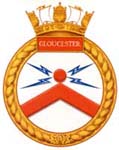 GLOUCESTER, Ontario - 1950 to 1972 (as a training facility). This was
a HFDF station during WWII and played a SIGINT role in the post war period.
Around 1948 the role of GLOUCESTER started to change from that of a DF
station to a radio training facility. It also became the home of the Special
Communications Branch. For the complete story on Gloucester,
select
this link. In the fall of 1972, Gloucester's duties were transferred
to the Canadian Forces School of Communications and Electronics Engineering
in Kingston, Ontario, now known as Canadian Forces School of Communications
and Electronics (circa 2005).
GLOUCESTER, Ontario - 1950 to 1972 (as a training facility). This was
a HFDF station during WWII and played a SIGINT role in the post war period.
Around 1948 the role of GLOUCESTER started to change from that of a DF
station to a radio training facility. It also became the home of the Special
Communications Branch. For the complete story on Gloucester,
select
this link. In the fall of 1972, Gloucester's duties were transferred
to the Canadian Forces School of Communications and Electronics Engineering
in Kingston, Ontario, now known as Canadian Forces School of Communications
and Electronics (circa 2005).
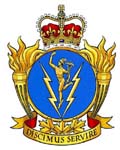 CANADIAN FORCES SCHOOL OF COMMUNICATIONS AND ELECTRONICS (CFSCE) Kingston,
Ontario, has remained at the leading edge of Communications and Electronics
training since 1937, first in the Canadian Army and now in the Canadian
Forces. CFSCE provides basic, intermediate and advanced training to military
personnel employed in the field of Communications and Electronics. Other
units headquartered (2008) at Kingston include the Land Force Doctrine
and Training System (LFDTS), Canadian Forces Joint Signal Regiment, 1 Wing
Headquarters (1 Wg HQ), Canadian Forces Joint Operations Group (CFJOG),
and 772 Electronic Warfare Squadron.
CANADIAN FORCES SCHOOL OF COMMUNICATIONS AND ELECTRONICS (CFSCE) Kingston,
Ontario, has remained at the leading edge of Communications and Electronics
training since 1937, first in the Canadian Army and now in the Canadian
Forces. CFSCE provides basic, intermediate and advanced training to military
personnel employed in the field of Communications and Electronics. Other
units headquartered (2008) at Kingston include the Land Force Doctrine
and Training System (LFDTS), Canadian Forces Joint Signal Regiment, 1 Wing
Headquarters (1 Wg HQ), Canadian Forces Joint Operations Group (CFJOG),
and 772 Electronic Warfare Squadron.
 CANADIAN FORCES FLEET SCHOOL, ESQUIMALT
CANADIAN FORCES FLEET SCHOOL, ESQUIMALT
In 1910, the transfer of Esquimalt and Halifax to Canada was formalized when the Naval Service Act inaugurated the Naval Service for the Dominion of Canada. The Naval shore facility at Esquimalt was commissioned as HMCS Naden on September 3, 1922. It was named for the facility's Depot Ship, HMCS Naden, a small wooden schooner built in 1913 that previously had been used for coastal surveys and cadet training. At the opening of WWII, the course offered to Ordinary Tels for the RCNVR Tel course at NADEN was only 6 weeks, while the course offered to the permanent force Ordinary Tels was 6 months!
The Canadian Forces Fleet School Esquimalt (CFFSE) first opened in HMCS Naden, Building 92 on 8 October 1958 as the Naval Technical School. Since then, CFFSE has evolved to become a comprehensive naval training facility, conducting over 200 courses for the full breadth of naval occupations for non-commissioned service members.
On 17 February 2009, The Communications Training Centre at Canadian Forces Fleet School Esquimalt was renamed to the CPO1 Ronald H. Guilderson Building. CPO1 Guilderson was a friend and mentor to many Canadian Forces sailors, in and out of the communications trades.“ He touched many sailors throughout his career, with his wit, charisma, and no-nonsense leadership approach,” said CPO2 Pierre Picard, who coordinated the ceremony. “It was only befitting that the Communications Training Centre be renamed after such a role model.”
Throughout his career, CPO1 Guilderson worked his way up to Chief Yeoman of Signals in HMCS Algonquin. He was the Base Chief Petty Officer between 1991 and 1994, and later became the MARPAC Fleet Chief Petty Officer before retiring in 1995.
Lou Dawson, C2FC, RCN Ret'd. served with the RCN from 1957 to 1985. He wanted to raise the issue of the purpose of deployment in North Atlantic waters. "Your articles describe some ships' duties as training-oriented. My experience on various ships was anything but. Usually, training was a term applied to short duration periods of specific tasking. For example, navigation officers would spend a couple of weeks going in and out (astern, of course) of some tricky harbours as part of their NavO qualifications. The ship would expect operating 'on exercises' in such cases.
Somewhat longer term tasks included Checkers and Newfie Patrol, both being primarily, but not exclusively, ASW in nature. These ordinarily lasted 30 days and included 1 or 2 overnights in Newfie-John for fuel, the best part of all, since it was always an overnight stay. (For those who doubt that it required that long to re-fuel, think 'gravity-fed' fuelling from tanks 'way they hell up on top of a hill.)
In the same time frame as the previous two were "show the flag" efforts that could take place almost anywhere: Great Lakes, Maritime ports, U.S. ports and, with luck, overseas. By far the longest deployments were those dedicated to training naval crews from different countries,i.e., European, to work together in a common sea environment. They usually lasted 3 to 4 1/2 months and were the precursors to STANAVFORLANT. So, "training" wasn't a term frequently used to describe Atlantic operations. Rather, we'd be conducting CARIBOPS, or EASTLANT. They were sometimes boring, but they included wonderful ports-of-call".
This is an aerial view of NADEN taken in 1969.
NOTES:
[1] As recalled from memory by Ernst Blais.
[2] This is the date solidly supported by Donald Courcy (VE2GG). He writes " I was in Skeena 2/65 Division and went through basic training in Cornwallis from September to December 1965. At the time, the Communication School was still in Cornwallis. I was shipped to Esquimalt at the end of December 1965 and went through my Radioman Trade Group One course at HMCS Naden from January to July 1966. This was a trial only. New Sparkers who came after me continued to take their Radioman TG1 course in Cornwallis. It is only upon completion of my TG1 course in July 1966 that the trial was declared a success and a decision was finally made to move the Comm School from Cornwallis to Naden. I believe the move was actually made in the summer of 1966.I also believe that the TG2 course was moved to Halifax at the same time as the TG1 course was moved to Esquimalt in the summer of 1966".
[3] In 2008, a Trade Qualification is called an Occupational Qualification
Level (OQL).
Credits and References:
1) http://www.cornwallismuseum.ca/CornwallisHistory.html
2) Canadian Warship Names. David J. Freeman. Vanwell
Publishing, St. Catharines, Ont. 2000
3) Ray White <legerwhite(at)rogers.com>
4) Crowsnest Magazine, December 1951
5) History of Canadian Signals Intelligence and Direction
Finding by Lynn Wortman and George Fraser 2005
6) http://www.recrutement.forces.gc.ca/v3/engraph/resources/educationtraining_en.aspx?bhcp=1
7) CFB Kingston http://en.wikipedia.org/wiki/CFB_Kingston
8) Stadacona, Cornwallis and Gloucester badges courtesy
Aye, Ready Aye. http://www.readyayeready.com/
9) CFCSE badge via DND.
10) James G. Dean <jgdean(at)sympatico.ca>
11) Crowsnest Magazine April 1949 and May 1950.
12) http://www.navy.forces.gc.ca/marpac/home/marpac_home_e.asp?category=4&title=303
13) http://www.navalandmilitarymuseum.org/info_pages/history/naden.html
14) CFFSE badge courtesy http://jfchalifoux.com/rcn.htm
15) Spud Roscoe <spudroscoe(at)eastlink.ca>
16) St. Hyacinthe badges and copy courtesy David J Freeman.
(C) 2007 D Freeman. Used with permission. E-mail: <djfreeman(at)shaw.ca>
17) David <D_E_Logie(at)shaw.ca>
18) Joe Grigg <joegrigg(at)aol.com>
19) Neil McKay, <Neill.McKay(at)gnb.ca>
20) Ernst Blais (250) 246-4645
21) Ken Chaddock <chaddock(at)hfx.eastlink.ca>
22) Donald Courcy <doncourcy(at)aol.com>
23) Guilderson story. Mary Ellen Green, Lookout Staff
Writer. Feb 2009
24) Bill Dziadyk <w.dziadyk(at)bdpro.ca>
Dec 19/20